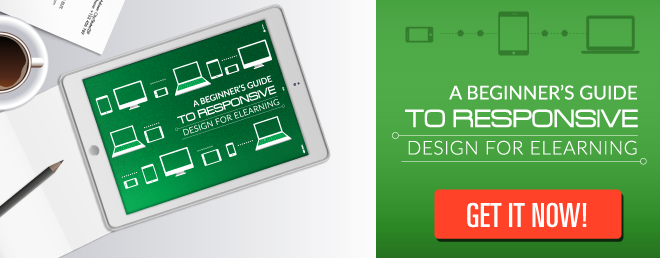Diving into today’s eLearning scene, creating courses that perform seamlessly across multiple devices isn’t just an added bonus—it’s absolutely essential.
Consider this: more than 70% of learners flip between computers, tablets, and smartphones to access their education. This isn’t just a shift; it’s a revolution in how we engage with and absorb knowledge.
Here's what every course designer needs to wrestle with: it's not enough to make texts legible on a small screen or ensure videos don’t buffer on a tablet.
The real challenge is making sure that someone glancing at their smartphone during a hectic subway ride gets as much out of their learning experience as another person who is comfortably clicking away on a desktop at home.
Imagine a commuter trying to pick up sales techniques on their phone during a rough bus ride. If that course isn’t optimized for mobile, with clear, readable text and user-friendly interactive elements, then we’re talking about a learning fail waiting to happen. It's a clear signal that thoughtful design needs to be a priority from the start.
Did you know a whopping 40% of users will abandon a page if it doesn’t load within three seconds? It shows that speed and optimization are non-negotiable when it comes to eLearning on multiple devices.
This article isn't just about laying down the essential rules to tackle these technical and learning challenges; it's about exploring ways to keep learners engaged and connected, no matter which device they’re using.
Let’s get into it!
Rule #1: Use the KISS Principle - Keep Navigation Simple
When designing for multiple devices, the key is to simplify navigation.
Consider a user learning on the go; they might be checking their course on a phone during a subway ride or on a tablet during a work break.
In these scenarios, being able to navigate the course easily using just a finger or two isn't just a convenience—it's a necessity.
Complex or confusing navigation can quickly frustrate users and lead them to abandon the course. Plus, on mobile devices, where space is limited and touch gestures are the main form of interaction, a cluttered interface can make it difficult to access necessary elements. Thus, intuitive, minimalist navigation helps keep the student’s focus and facilitates distraction-free learning.
Our top tip: Always design with the smallest screen in mind. A practical trick is to use a large, clearly labeled "Menu" button, removing the guesswork of how to navigate. Also, make sure icons and buttons are big enough to be easily tapped without mistakes, and ensure navigation cues are clear and consistent across all interfaces. This guarantees that no matter the device, you can manage the course efficiently and without frustration, significantly improving the learning experience.
Also read: Road Map to Success: Mobile Learning Essentials
“Small screen sizes force you to prioritize what really matters to your customers and business. There simply isn’t room for anything else.” Luke Wroblewski
Rule #2: Focus on Low Information Density
In designing courses for multiple devices, it's critical to understand that less is more. Today's learners are often on the move and face constant distractions, which reduces their attention span.
Moreover, the limited memory capacity of mobile devices and concerns about battery life also play a significant role. This means content needs to be straightforward and easily digestible.
Imagine someone trying to learn a complex concept while waiting in line at the coffee shop. If the content is dense and lengthy, they're likely to lose interest quickly or feel overwhelmed. Therefore, it's crucial to structure the material in small chunks, ideally requiring no more than five minutes each to understand.
Practical tip: Break the content into short, standalone modules. This allows the learner to access the course non-linearly and refer back to specific information as needed.
For example, you could design a module focused exclusively on a single concept or technique, with clear and concise examples. Remove any superfluous information that doesn't directly contribute to the learning goal. This not only makes the content more manageable but also enhances information retention and optimizes the learning experience, keeping the student engaged and focused on the essentials.
Also read: Start Thinking of Micro Learning Moments Now
Rule #3: Design for Visual Clarity
Achieving visual clarity in eLearning course design across multiple devices is critical for ensuring that students can easily access, understand, and remember the material.
Visual clarity involves organizing, presenting, and making content accessible in a way that's instantly clear at first glance. This means employing a streamlined design, choosing the right colors and fonts, and arranging screen elements logically.
Consider a learner accessing the course outside or in a dimly lit room at home. In both scenarios, the content needs to be easy to read and understand without any additional strain. Key factors like font size, color contrast between text and background, and a simplified layout are essential to support learning under any conditions.
Here's a practical tip: Opt for large, bold headings to break down content into manageable chunks. Transform long paragraphs into bullet points or numbered lists to quickly highlight and clarify key concepts. Use icons and a consistent color palette to visually lead students through the course. For example, designate a specific color for important actions and another for summarizing sections, creating an intuitive visual path for learners to follow.
By implementing these design principles, you not only enhance readability and accessibility on smaller screens but also ensure that learners can concentrate and absorb information effectively, regardless of varying lighting conditions or distractions. This approach fosters an effective and enjoyable learning experience for all environments.
Recommended reads:
Mobile Usage Habits of Today’s Corporate Learner
Embracing a Mobile Mindset for Learning and Development
Rule #4: Make Content Searchable
A key feature for a successful multi-device eLearning course is making the content easy to find. This means learners should be able to quickly locate any specific section or module without navigating through complicated menus or cluttered interfaces.
Think of someone needing to quickly review a topic before a meeting or while preparing a project; the ability to access information swiftly and directly can make a big difference in their learning experience. Therefore, clarity in content organization and intuitive navigation are crucial.
Practical tip: Use descriptive and straightforward titles for each module and section. Avoid ambiguous or creative terms that might confuse the student about the content they'll find under that title. Also, implement an interactive index and an easy-to-navigate menu that's always accessible, no matter where in the course the user is. For example, you could design a side menu that, with a simple tap, shows all the section and subsection titles, allowing the student to jump directly to the desired content.
By improving how content is labeled and organized and by offering clear navigation tools, you not only make learning more effective but also more enjoyable and less frustrating for learners, thus facilitating a smoother and more satisfying experience.
Rule #5: Minimize Scrolling
One of the key aspects of enhancing the usability of eLearning courses on multiple devices is minimizing vertical scrolling.
When someone has to constantly scroll to access content, it can become a barrier that diminishes the effectiveness of learning and increases visual and mental fatigue. Ideally, the content on a mobile device screen should not extend beyond three screen scrolls.
Practical tip: Divide content into screens or pages that only occupy half the screen, complemented by a clear "next" button. This allows learners to move through the material without needing to scroll too much. Additionally, keep all secondary content like optional navigation controls and less relevant links at the end of the page. This way, the initial part of the screen is reserved for the most important content, ensuring that the main content captures attention without distractions.
Take this opportunity to review the current design of your courses.
-
Does your design truly provide a seamless and accessible learning experience for everyone, across all devices?
-
Is your content reaching every learner effectively, regardless of whether they're using a smartphone, tablet, or desktop?
-
Could simplifying certain design elements or tweaking the layout reduce unnecessary scrolling and improve overall visual clarity?
-
Are there distractions or complications that could be eliminated to enhance the learner's journey through the course?
Reflecting on these questions will help you not only maintain a competitive edge but also ensure that your courses offer meaningful and engaging learning experiences.
This isn't just about keeping up with trends—it's about setting the standards for excellence in eLearning.




